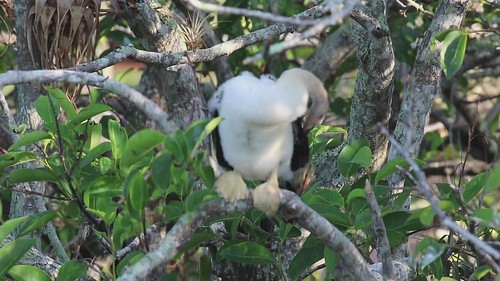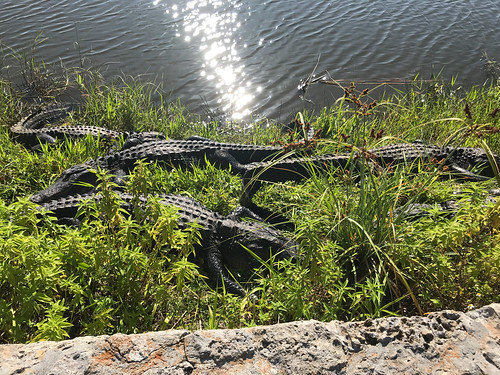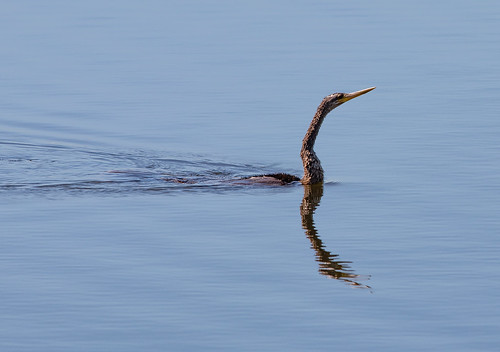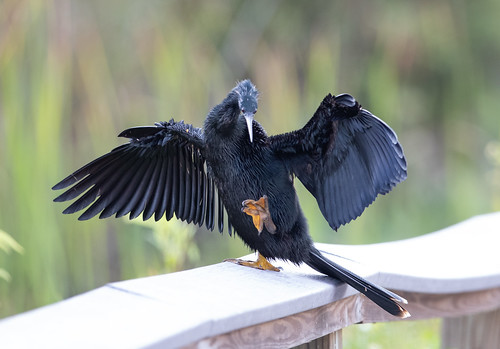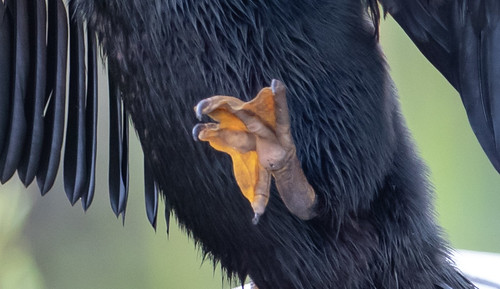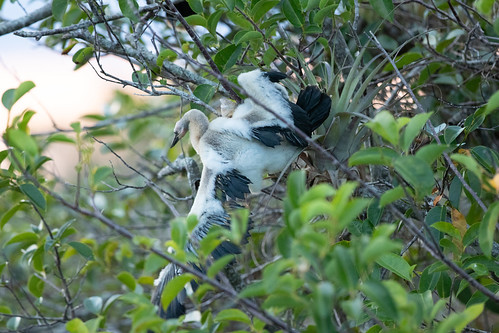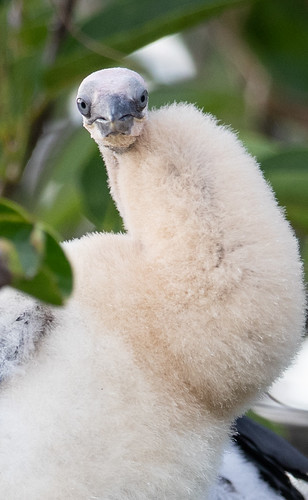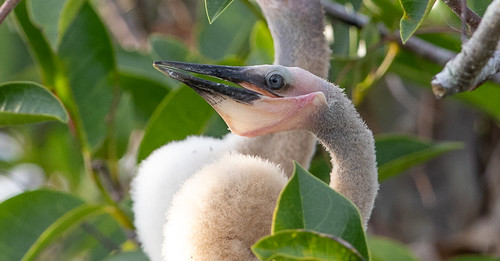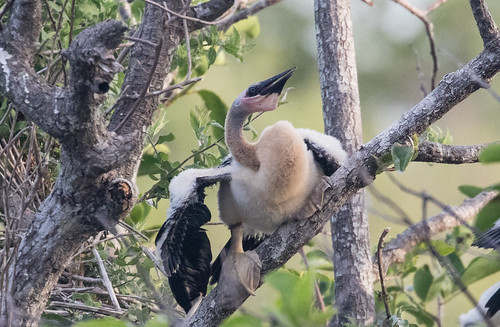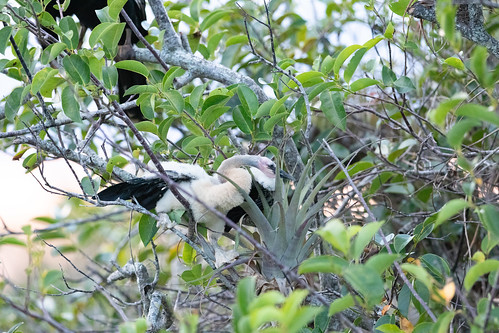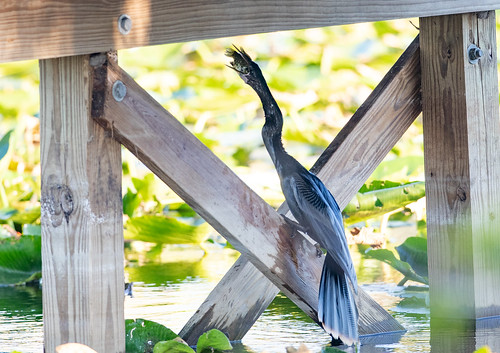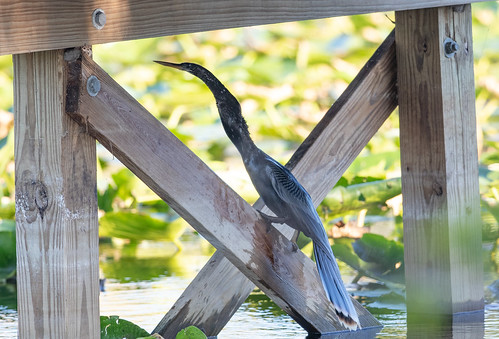This trail, which starts at the Royal Palm Visitor Center, is a paved walkway and a boardwalk over Taylor Slough, a freshwater sawgrass marsh teeming with life. The trail is just 0.4 miles long, so it's less than a mile to walk to the end and back including taking the little side loops. The only problems with the trail are that it is so heavily used that it can be hard to make good videos and sound recordings that don't pick up people's voices, and that a surprising number of airplanes fly over, making an even noisier background. But I've made some excellent recordings there early in the morning, when natural sounds are finest and people are mostly still in bed.
 |
| Most people seem to come to the Anhinga Trail to see alligators. This poor Anhinga couldn't attract anyone's attention. |
For such a short, easy walk, the wildlife is amazingly abundant. I could talk about the seven alligators that were all sunning just inches from the wall at the entrance—I had to use the panorama function on my cell phone to get them all in one photo.
And colorful eastern lubber grasshoppers were everywhere.
But the three times we walked the trail on this trip, I was so absorbed with Anhingas that I didn't pay all that much attention to anything else. Adults were everywhere, flying, swimming, perched on the guardrails and in the trees.

The Anhingas allowed me to come close enough that I even got photographic proof that they do have a preen gland.
Why must they hold their wings out to dry them, and even flap them to shake out the water, then? Oils from preen glands don't really "waterproof" any bird's feathers. Those oils simply keep feathers in good condition. As birds that fish most efficiently by staying submerged, anhingas and cormorants have wonderfully wettable feathers. When an Anhinga's feathers get soaked, good condition or not, they hold a lot of moisture.
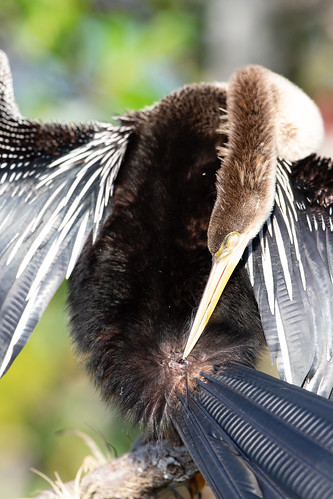 |
| Yep--the preen gland! |
 |
| Shaking out wings to dry the soaked feathers. |
 |
| This female Anhinga is sitting in the typical open-wing posture to help dry her wing and body feathers |
One male sitting on the guard rail seemed to want to demonstrate what "totipalmate" means by holding his foot up to show me. All four of an Anhinga's toes are webbed, unlike the way only the three front toes of a gull or duck are webbed.
One pair was nesting at the beginning of the trail, and two pairs of fuzzy chicks were tucked into the dense foliage in trees further along, still too young to be making tentative flights.
Falling into the water would be lethal—everywhere there were alligators hoping to capitalize on clumsy young birds. Oddly enough, many wading birds, including Anhingas, benefit from those very alligators, which make short work of predators swimming to a nesting tree, too.
Falling into the water would be lethal—everywhere there were alligators hoping to capitalize on clumsy young birds. Oddly enough, many wading birds, including Anhingas, benefit from those very alligators, which make short work of predators swimming to a nesting tree, too.
But thanks to those alligators, individual babies must cling to their branches for dear life, quite literally. For a chick to simply turn around to face the opposite direction on a branch takes all its concentration and balance. Anhinga feet have strong, gripping toes and sturdy claws, and determination and spunk also help. I watched one baby end up literally upside down when it let go of a branch with one foot trying to move it to the next branch. The other foot stayed latched to the branch, and the baby managed to get its leg and wing hooked to the branch as well. The alligators were left with a fish dinner that night.
While the parents were off fishing, the two chicks spent their time snoozing, preening, looking about, toying with branches and moving around a bit, and watching each other. I took hundreds of photos (all linked to on my Anhinga Page, though the algorithm adds all the photos I've taken at the Anhinga Trail, too).
Their heads looked bizarrely tiny when they were facing me directly, especially above all the thick downy feathers on their necks.
The narrow, streamlined head lived up to the Anhinga’s nickname, “snakebird,” but as befits a species that feeds on rather large fish, the mouth has to be able to open wide. These chicks could somehow set their jaw to make their head much wider, the skin stretching weirdly over the slender bones.
The moment a parent flew into the tree, the two chicks instantly engaged in a competition to see which could seem most desperate for food. They made non-stop begging sounds (you can hear the recording I made on this trip here) while fluttering their wings and gaping.
The newly-arrived parent ignored them for several minutes, an important time lag while the adult’s stomach juices softened the fish. The babies waved their wings wildly and tried hopping and climbing between branches and stretching their long necks to get closer, but didn’t seem to influence the feeding schedule.
Adult and chick Anhingas have such long, sharp beaks that the feeding bouts looked dangerously violent, but the babies had grown and thrived being fed this way since hatching with not a single injury to show for it. There were dozens of Anhingas on this short trail—I don’t think we could look in any direction without both seeing and hearing them, and every single one of them had started its life just as these two chicks were, jousting for food with those dagger-like bills. The parents could hardly warn them that they could poke someone’s eye out with that thing when their own bills were even longer, sharper, and more dangerous.
I also got lots of photos and videos of the chicks.
Everything about my time on the Anhinga Trail made me happy to be alive on a little planet teeming with such splendid lifeforms. If Russ and I get back one day in the murky future, there’s no way we’ll recognize these individual Anhingas. But we’ll see something of them in every other Anhinga we see. I feel wonderfully rich thanks to these splendid birds sharing their time with me.
